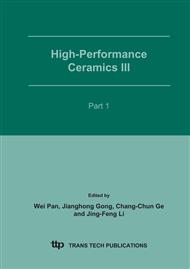p.1571
p.1575
p.1581
p.1585
p.1589
p.1595
p.1599
p.1605
p.1609
Mechanism of Apatite Formation on Sol-Gel Derived PDMS-Modified SiO2-CaO-P2O5 Hybrids with Various P2O5 Content
Abstract:
The mechanism of apatite formation on the surface of novel PDMS modified SiO2-CaO- P2O5 hybrids is presented. The bioactive hybrids with different P2O5 content were synthesized by sol-gel method and soaked in the simulated body fluid (SBF) for different periods. The surface and the cross-section of the specimens were examined by use of Fourier transform infrared reflection spectroscopy, thin-film X-ray diffraction technique and scanning electron microscopy. The PDMS-SiO2-CaO-P2O5 hybrid containing 0.03 mole ratio of TEP(triethyl phosphate) / TEOS (tetraethoxysilane) exhibited faster apatite formation compared to P2O5-free hybrids. This composition resulted in the thickest apatite layer (~6µm) and this might be attributed to faster formation of the silica hydrogel on the surface of the P2O5-containing hybrids than on the surface of the P2O5-free hybrids. Resultingly, the apatite nucleation on the surface of the P2O5-containing hybrids is effectively induced by the hydrated silica at a lower degree of supersaturation. Changes in concentrations of the calcium, silicon and phosphorus in the SBF and the SEM-EDS line analysis depicting the variation of Si, Ca and P elements for the bulk, the interface and the apatite are reported. These were found to be quite correlative with each other. The rate of the concentration changes for the P2O5-containing hybrids is higher than that of the P2O5-free hybrids. The increases in the calcium and silicon concentrations are attributed to dissolution of the calcium and silicate ions from the hybrids, and the decrease in the phosphorus concentration is ascribed to formation of the amorphous calcium phosphate and crystalline apatite on the surface of hybrids by consuming the phosphate ion from the fluid.
Info:
Periodical:
Pages:
1589-1594
Citation:
Online since:
February 2007
Authors:
Price:
Сopyright:
© 2005 Trans Tech Publications Ltd. All Rights Reserved
Share:
Citation:


